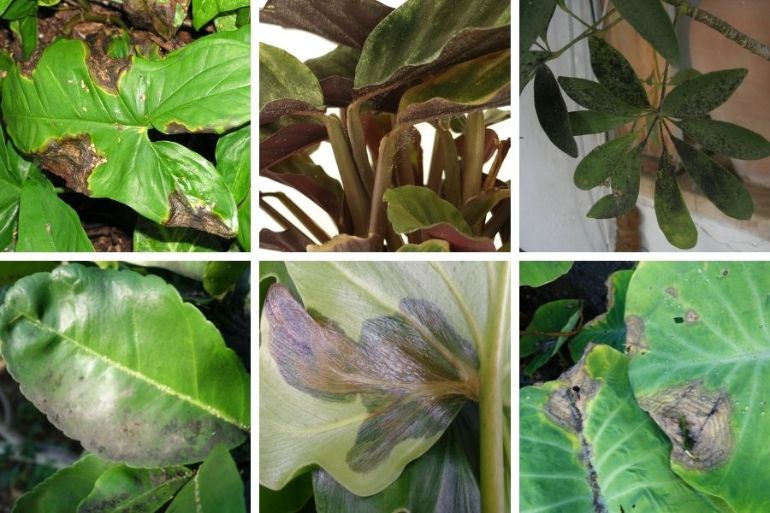When you purchase through links on our site, we may earn an affiliate commission. Here’s how it works.
Youre strolling through your garden enjoying the lush growth the spring rains have produced. You stop to admire one particular specimen and you notice black spots on plant leaves. Closer inspection shows black spots on leaves throughout a whole section of your garden. This cant be! You dont have any roses. Unfortunately, you dont need them. Your garden has been infected with black spot fungus.
Black spots on plant leaves are a common issue that can have several different causes. As a plant owner, it’s important to understand the various reasons black spots can appear, so you can properly treat and prevent them. This article will examine the top causes of black spots on plant leaves and provide solutions to get your plants healthy again.
What Are Black Spots?
Black spots can appear on the leaves, stems, or flowers of plants as small dark dots that may enlarge over time. These spots are areas where plant cells have died, a process called necrosis. Several factors can cause this localized death of plant tissue, including:
- Fungal or bacterial diseases
- Environmental stresses like overwatering or improper lighting
- Pests like thrips
- Physical damage to the plant
While the spots themselves don’t spread, the underlying issue such as a disease or pest infestation can affect the rest of the plant if left untreated.
5 Common Causes of Black Spots on Plants
1. Fungal Leaf Spot Diseases
One of the most prevalent causes of black spots is fungal disease Fungi like anthracnose, leaf spot, and blights can infect plants
- Spots start small and expand, sometimes with yellow halos.
- More prevalent in humid, wet conditions.
- Treat with fungicide sprays after isolating plant. Improve air circulation.
2. Bacterial Infections
Bacteria like pseudomonas and xanthomonas cause dark greasy spots.
- Spots spread rapidly, often leaking liquid.
- Disinfect tools after pruning infected areas. Use copper sprays as a last resort.
3. Root Rot from Overwatering
Overly moist soil leads to root rot, which causes black spots.
- Spots are often soft or mushy.
- Check soil moisture and drainage. Let plant dry out before watering again.
4. Pests Like Thrips
Insects can leave behind black fecal spots and damage
- Look for tiny insects and webs. Wipe leaves to remove debris.
- Spray insecticidal soap or neem oil.
5. Environmental Stresses
Issues like improper lighting or low humidity cause black spots.
- Dry, crispy spots indicate sunburn from too much light.
- Move plant to suitable location based on its light needs.
How to Prevent and Treat Black Spots
If you notice black spots, isolate the affected plant immediately to avoid spreading. Remove badly damaged leaves. Improve airflow and avoid wetting the leaves when watering.
To treat fungal or bacterial diseases, use copper, sulfur or neem oil sprays as directed. Control pests with insecticidal soap. For environmental issues, modify watering, lighting, temperature or humidity.
With prompt treatment, black spot damage can be limited and controlled. Keep plants healthy through proper care and you can avoid many causes of black spots in the first place. Monitor plants frequently for early detection of any problems.
FAQs about Black Spots on Plants
What causes black spots on plant leaves?
The main causes are fungal/bacterial diseases, pests, overwatering issues, environmental stresses, and physical damage.
How do you get rid of black spots on plants naturally?
Remove affected leaves promptly. Improve airflow. Treat with neem oil or homemade sprays like baking soda/vinegar solutions.
Can black spots on leaves be wiped off?
Black spots can’t be wiped away if they are areas of dead tissue. But some pest debris may wipe away.
Do black spots on leaves mean the plant is dying?
Not necessarily – many plants can recover if the underlying issue is addressed. But black spots indicate a problem requiring treatment.
How do I know if black spots on leaves are fungal or bacterial?
Fungal spots have more defined edges and may have yellowing. Bacterial spots are more irregular and leak liquid when damaged.
The Bottom Line
Don’t panic if you see black spots on plant leaves. Just be sure to identify the cause and take prompt action to resolve the issue. With appropriate treatment and good plant care, black spot damage can be limited and controlled, allowing your plants to regain their beauty. Be vigilant with inspections so problems can be caught early before they spread.

What is Black Spot Fungus?
Dont let the name fool you. Diplocarpon rosae, or black spot fungus, isnt just a disease of roses. It can attack any plant with fleshy leaves and stems if the conditions are right.
Youve already taken the first step in treating black leaf spot. Youve been inspecting your garden on a regular basis and youve caught it early.
Black spot fungus begins to develop in the spring when temperatures reach into the sixties and the garden has been continuously wet for six to nine hours. By the time temperatures reach into the seventies, the disease is running rampant and wont slow down until the daytime temperatures rise above 85 F. (29 C.).
It starts with tiny black spots on leaves, no bigger than a pinhead. As the fungus develops, those black spots on leaves are ringed with yellow. Soon the entire leaf turns yellow and falls.
